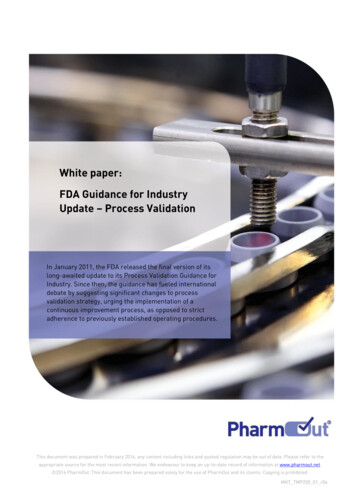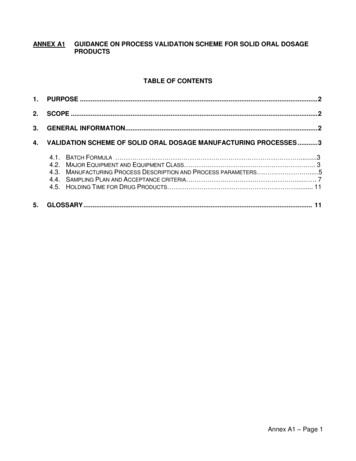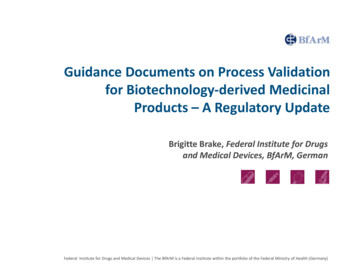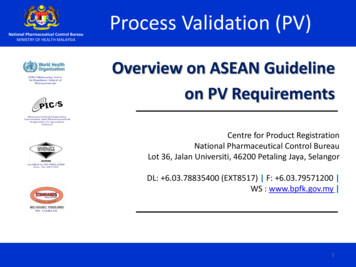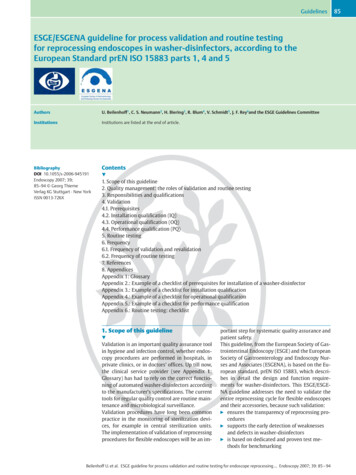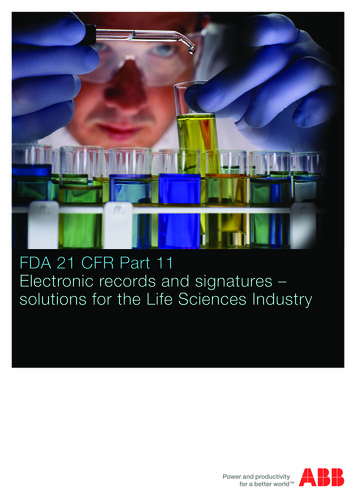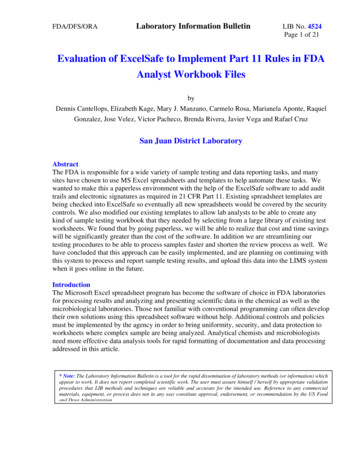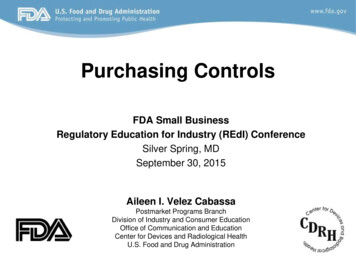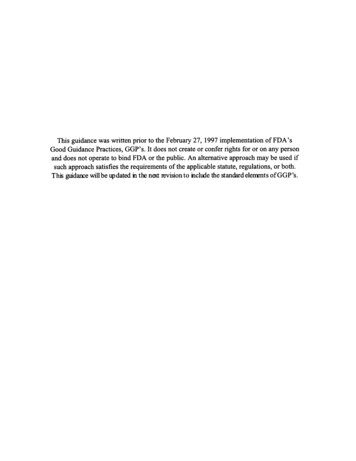
Transcription
This guidance was written prior to the February 27, 1997 implementation of FDA'sGood Guidance Practices, GGP's. It does not create or confer rights for or on any personand does not operate to bind FDA or the public. An alternative approach may be used ifsuch approach satisfies the requirements of the applicable statute, regulations, or both.This guidance will be up dated in the next revision to include the standard elemnt s of GGP 's .
GUIDELINE ON GENERAL PRINCIPLES OF PROCESS VALIDATIONMay 1987Prepared by:Maintained by:Center for Drugs and Biologics andCenter for Devices and Rad ologicalHealthFood and Drug AdministrationDivision of Manufacturing and Product Quality (HFN-320)Center for Drugs and BiologicsFood and Drug Administration5600 Fishers LaneRockville, Maryland 20857
TION1DEFINITIONS1IV.GENERAL CONCEPTS2v.VI .CGMP REGULATIONS FOR FINISHED PHARMACEUTICALS3GMP REGULATION FOR MEDICAL DEVICES4PRELIMINARY CONSIDERATIONS5VII.VIII. ELEMENTS OF PROCESS VALIDATIONA. Prospective Validation1. Equipment and Process556a. Equipment: Installation Qualification6b. Process: Performance Qualification7c. Product: Performance Qualification82. System to Assure Timely Revalidation93. Documentation9B. Retrospective Process Validation9IX. ACCEPTABILITY OF PRODUCT TESTING10
GENERAL PRINCIPLES OF PROCESS VALIDATIONI.PURPOSEThis guideline outlines general princi les that FDA considers to be acceptable elements ofprocess validation for the preparation o human and animal drug products and medical devices.!11.SCOPEThis guideline is issued under Section 10.90 (21 CFR 10.90) and is applicable to the manufacture of pharmaceuticals and medical devices. It states principles and practices of generalapplicability that are not legal requirements but are acceptable to the FDA. A person mayupon this guideline with the assurance of its acceptability to FDA, or may followdi ferent procedures. When different procedures are used, a person may, but is not requiredto. discuss the matter in advance with the FDA to prevent the expenditure of money and efforton activities that may later be determined to be unacceptable. In short, this guideline listsprinciples and practices which are acceptable to the FDA for the process validation of drugproducts and medical devices; it does not list the principles and practices that must, in all nstances,be used to comply with law."1YThis guideline may be amended from time to time. Interested persons are invited to submitcomments on this document and any subsequent revisions. Written comments should be submittedto the Dockets Mana ement Branch (HFA-305), Food and Drug Administration, Rm.4-62, 5600Fishers Lane, Rockvi le, Maryland 20857. Received comments may be seen in that office between9:00 a.m. and 4:00 p.m. Monday through Friday.f111.INTRODUCTIONProcess validation is a requirement of the Current Good Manufacturing Practices Re ulationsfor Finished Pharmaceuticals, 21 CFR Parts 210 and 21 1, and of the Good Manu acturingPractices Regulations for Medical Devices, 21 CFR Part 820, and therefore, is applicable tothe manufacture of pharmaceuticals and medical devices.BSeveral firms have asked FDA for specific guidance on what FDA expects firms to do to assurecompliance with the requirements for process validation. This guideline discusses processvalidation elements and concepts that are considered by FDA as acceptable parts of a validation program. The constituents of validation presented in this document are not intendedto be all inclusive. FDA recognizes that, because of the reat variety of medical products(drug products and medical devices), processes and manu acturing facilities, it is not possible to state in one document all of the specific validation elements that are applicable.Several broad concepts, however, have general applicability which manufacturers can use successfully as a guide in validating a manufactunng process. Although the particular processvalidation will vary according to such factors as the nature of the medical product (e. .,sterile vs non-sterile) and the complexity of the process, the broad concepts stated in t isdocument have general applicability and provide an acceptable framework for building a comprehensive approach to process validation.fiDEFINITIONSInstallation Qualification - Establishing confidence that process equipment and ancillarysystems are capable of consistently operatmg within established limits and tolerances.Process Perforinance Qualificationreproducible.-Establishing confidence that the process is effective and
Product Performance Qualification - Establishing confidence through appropriate testing thatthe finished product produced by a specified process(es) meets all release requirements forfunctionality and safety.Prospective Validation - Validation conducted rior to the distribution of either a newproduct, or product made under a revised manu acturing process, where the revisions mayaffect the product's characteristics.PRetrospective Validation - Validation of a process for a product already in distributionbased upon accumulated production, testing and control data.Validation - Establishing documented evidence which provides a high degree of a high degreeof assurance that a specific process will consistently produce a product meeting its predetermined specifications and quality attributes.Validation Protocol - A written plan stating how validation will be conducted, including testparameters, product characteristics, production equipment and decision points on what constitutes acceptable test results.Worst Case - A set of conditions encompassing upper and lower processing limits and circumstances, including those within standard operating procedures, which pose the greatest chanceof process or product failure when compared to ideal conditions. Such conditions do notnecessarily induce product or process failure.IV.GENERAL CONCEPTSAssurance of product quality is derived from careful attention to a number of factors includin selection of quality parts and materials, adequate product and process desi n, control o the process, and in-process and end-product testing. Due to the complexity o today'smedical products, routine end-product testing alone often is not sufficient tp assure productquality for several reasons. Some end-product tests have limited sensitivity. In some casesdestructive testing would be required to show the manufacturing process was adequate and inother situations end-product testing does not revgal all variations that may occur in theproduct that may impact on safety and effectiveness.FfThe basic principles of quality assurance have as their goal the production of articles thatare fit for their intended use. These principles may be stated as follows:( I ) quality, safety, and effectiveness must be designed and built into the product;(2) quality cannot be inspected or tested into the finished product; and,(3) each ste of the manufacturing process must be controlled to maximize the probabilitythat the inished product meets all quality and design specifications.g(11For example, USP X X states: "No sampling plan for applying sterility tests to aspecified proportion of discrete units selected from a sterilization load is capable ofdemonstrating with complete assurance that all of the untested units are in fact sterile."( 2 )As an example, in one instance a visual inspection failed to detect a defectiveStructural weld which resulted in the failure of an infant warmer. The defect could only havebeen detected by using destructive testing or expensive test equipment.
Process validation is a key element in assuring that these quality assurance goals are met.It is through careful design and validation of both the process and process controls that amanufacturer can establish a high degree of confidence that all manufactured units fromsuccessive lots will be acceptable. Successfully validating a process may reduce the dependenceJupon intensive in-process and finished-product testmg. It should be noted that in mostall cases, end-product testing plays a major role in assuring that quality assurance goalsare met; i.e., validation and end-product testing are not mutually exclusive.The FDA defines process validation as follows:Process validation is establishing documented evidence which provides a high degree ofassurance that a specific process will consistently produce a product meeting its predetermined specifications and quality characteristics.It is important that the manufacturer prepare a written validation protocol which specifiesthe procedures (tests) to be conducted and the data to be collected. The purpose for whichdata are collected must be clear, the data must reflect facts, and the data must be collectedcarefully and accurately. The protocol should specify a sufficient number of replicateprocess runs to demonstrate reproducibility and provide an accurate measure of variabilityamong successive runs. The test condition for these runs should encompass upper and lowerprocessing limits and circumstances, including those within standard operating procedures,which pose the greatest chance of process or product failure compared to ideal conditions;such conditions have become widely known as "worst case" conditions. (These are sometimecalled "most appropriate challenge" conditions.) Validation documentation should includeevidence of the suitability of materials and the performance and reliability of equipment andsystems.Key process variables should be monitored and documented. Analysis of the data collected frommonitoring will establish the variability of process parameters for individual runs and willestablish whether or not the equipment and process controls are adequate to assure thatproduct specifications are met.Finished product and in-process test data can be of value in process validation, particularlyin those situations where quality attributes and variabilities can be readily measured. Wherefinished (or in-process) testing cannot adequately measure certain attributes, process validation should be derived primarily from qualification of each system used in production andfrom consideration of the interaction of the various systems.V. CGMP REGULATIONS FOR FINISHED PHARMACEUTICALSProcess validation is required in both general and specific terms, by the Current GoodManufacturing Practice Regulation for Finished Pharmaceuticals, 21 CFR Parts 210 and 21 1.Examples of such requirements are listed below for informational purposes, and are.not allincluswe.A requirement for process validation is set forth in general terms in 21 CFR 21 1.100--Written procedures; deviations -- which states, in part:"There shall be written procedures for production and process control designed to assurethat the drug products have the identity, strength, quality, and purity they purport orare represented to possess."
Several sections of the CGMP regulations state validation requirements in more specificterms. Excerpts from some of these sections are:Section 2 11.110, Sampling and testing of in-process materials and drug products.(a) ".control rocedures shall be established to monitor the output and VALIDATE theperformance o r those manufacturing processes that may be responsible for causingvariability in the characteristics of in-process material and the drug product.(emphasis added)Section 2 1 1.1 13, Control of Microbiological Contamination.(b) "Appropriate written procedures, designed to prevent microbiological contamination ofdrug products purporting to be sterile, shall be established and followed. Such procedures shall include VALIDATION of any sterilization process." (emphasis added)VI.GMP REGULATION FOR MEDICAL DEVICESProcess validation is required by the medical device CGMP Regulation, 21 CFR 820. Section820.5 requires every fin sheddevice manufacturer to:".prepare and implement a quality assurance program that is appropriate to the specificdevice manufactured. ."Section 820.3(n) defines quality assurance as:".all activities necessary to verify confidence in the quality of the process used tomanufacture a finished device. "When applicable to a specific process, process validation is an .essential element in establishing confidence that a process will consistently produce a product meeting the designedquality characteristics.A generally stated requirement for process validation is contained in Section 820.100:"Written manufacturing specifications and processing procedures shall be established,implemented, and controlled to assure that the device conforms to its original design orany approved changes in that design."Validation is an essential element in the establishment and implementation of a processprocedure, as well as in determining what process controls are required in order to assureconformance to specifications.Section 820.100(a)(l) states:".control measures shall be established to assure that the design basis for the device,components and packaging is correctly translated into approved specifications. "Validation is an essential control for assuring that the specifications for the device andmanufacturing process are adequate to produce a device that will conform to the approveddesign characteristics.
VII. PRELIMINARY CONSIDERATIONSA manufacturer should evaluate all factors that affect product quality when designinandundertaking a process validation study. These factors may vary considerably among di ferentproducts and manufacturing technologies and could include, for example, component specifications, air and water handling systems, environmental controls, equipment functions, andprocess control operations. No single approach to process validation will be appropriate andcomplete in all cases; however, the following quality activities should be undertaken in mostsituations.BDuring the research and development (R&D) phase, the desired product should be carefullydefined in terms of its, characteristics,
This guideline discusses process validation elements and concepts that are considered by FDA as acceptable parts of a val- idation program. The constituents of validation presented in this document are not intended to be all inclusive. FDA recognizes that, because of the reat variety of medical products (drug products and medical devices), processes and manu f acturing facilities, it is not .
